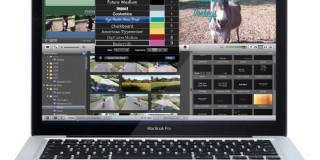Radeon Pro Vega 56 vs. Vega 64: Choosing the Right GPU for your iMac

What should you pick between the two graphics card options included in the iMac Pro?
Apple’s newest flagship all-in-one personal computer, the iMac Pro showcases premium hardware, some of which you have different options of. You have the option to customize your iMac Pro before it leaves the assembly line. Apple presents you with a few ways to this – by upgrading your RAM, processor, storage, accessories, and other things.
Among these options is the ability to choose between graphics cards. While an NVIDIA card is still hands-off, you will be able to build your iMac Pro with either of these high-end graphics card by AMD – the Radeon Pro Vega 64, or Vega 56.
Both of these graphics cards are powered by the same architecture. AMD’s Vega allows for up to 22 teraflops and 11 teraflops of half-precision and single-precision computing, respectively. On top of that is Vega’s High Bandwidth Memory (HBM2). This power combo results to higher frame rates when playing games. It also results to better benchmark, faster graphics rendering. And lastly, smooth optimized operation of the 5K Retina P3 display.
Both cards have pretty good performance. Below, this article will explore the pros and cons of each of them. If you need help choosing between the two cards, read on.
Choosing the Radeon Pro Vega 56 Graphics Card with 8GB of HBM2 Memory
Vega 56 provides full graphics power performance, as it is Apple’s baseline graphics card as of the iMac Pro. It complements the iMac Pro’s 5K retina display and provides maximum performance in rendering graphics, resulting in high frame rates when running games and other video card-heavy applications.
If you are going to use the iMac Pro mainly for gaming or as a VR machine, Vega 56 is more than sufficient to perform those tasks. Benchmark results comparing the two cards can be viewed on GamersNexus, although these results are from custom PC builds which do not have iMac Pro’s processing unit in use.
However, for developer-focused applications such as 3D painting software, video editors, VFX and Virtual Reality development, Vega 56’s 8GB RAM capacity may fall short. VR expert Russell Holly from iMore elaborates the difference between the two cards.
The Differences in Applications Use
There is no significant difference between the two graphics cards when used for gaming. But when using tools used for graphic arts and game development, the difference might be more noticeable. This is because tools used for these maxes out the card. Power users such as graphic artists or animators and game developers may notice a great deal of difference in performance between the two graphics cards, but the average consumer may not.
Designers and developers may naturally gravitate to having the Vega 64 as the more suitable option. But Apple also offers a third option – a support for eGPUs or external GPU enclosures. This is still in Beta phase but will soon be the next standard for iMacs.
Results of the first iMac Pro impressions interviews with developers are very impressive. Some iMac Pro users have tried chaining multiple eGPUs to their iMac Pro. This resulted to significant boost in performance when doing visual-heavy tasks. This is very good news for those who want to make use of iMac Pro’s premium hardware. Also, for those who do not want to be limited to the power offered by Apple’s graphic architecture.
So, if you are currently planning on using your iMac for gaming in the meantime and availing of eGPUs in the near future, sticking with the Vega 56 might be the best choice or you.
Choosing the Radeon Pro Vega 64 Graphics Card with 16GB of HBM2 Memory
But of course, if you are one of those professionals who want the best build possible, Vega 64 may be the best choice. For $600 more, Vega 64 provides your iMac Pro the best GPU power even without the eGPU enclosures upgrade. It has two times the HBM2 memory provided by the Vega 56, which means that more heavy application softwares can be run smoothly on your iMac Pro.
As far as iMac Pro upgrades go, inserting a Vega 64 graphics card is actually one of the cheapest upgrades you can avail of to improve performance, but has the most noticeable impact.
To compare prices, a Thunderbolt 3 eGPU enclosure may cost you $300-$500. You can avail this at Mantiz’s Venus for $389, while an external Vega 64 card can be bought on B&H Photo for $750..
So, i you’re aiming for the most possible power you can extract out of a graphics card, you may choose the Vega 64 as a baseline. Then, pair it with a eGPU like the Thunderbolt 3. Although, if you will not be using the iMac Pro for heavy development purposes, this build may be a bit of an overkill.















